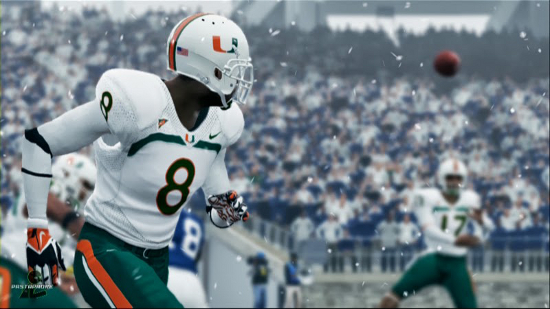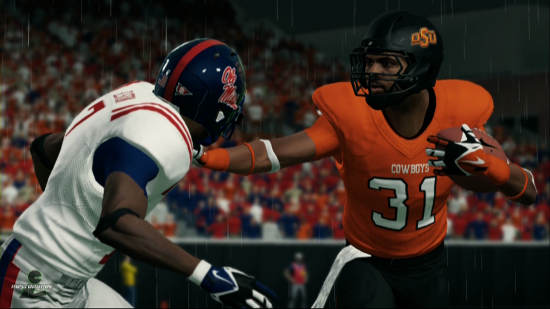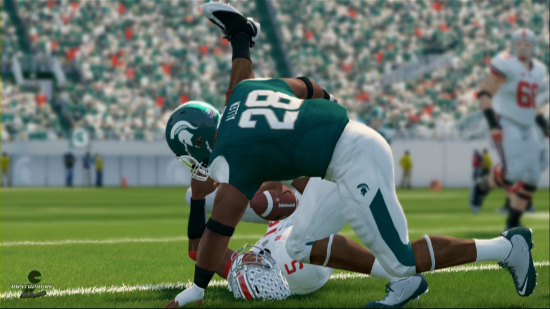NCAA Football 14: Hits and Misses

In recent years the NCAA Football series has lacked ambition, innovation, and even proper execution of features. With NCAA Football 14 however those concerns have been largely washed away and the result is a fun football video game that isn’t necessarily a great college football video game. Continue on for an assessment of where NCAA 14 has succeeded and where it falls short in this Hits and Misses review.
HITS
Gameplay Improvements
Fun factor is often overlooked, and difficult to quantify, but there is little doubt that NCAA 14 offers more of it than recent iterations largely due to the work done on gameplay. The “Infinity” engine physics provide a huge upgrade not just in how the game looks but how it plays. Exceptional player control, significant blocking improvements, and more moves at the disposal for ball carriers make the run game far more enjoyable and effective. Option plays – which can be run now by both the CPU and users without failing miserably – are especially satisfying.
The CPU AI provides a much more realistic challenge. Every play can be utilized with the CPU QB much smarter about where to go with the ball and runners who have vision. When playing defense the weaknesses of the CPU’s offensive AI have always been present making things predictable and boring but that is no longer the case. The only problems seen have been with the CPU’s late game clock management and decision making which has been questionable at times. The various offensive styles all have the potential to gash defenses. Ratings really play more of a role in NCAA 14 than ever before. Highly rated defenses will be able to stop the attacks with which they are best equipped to do so but those comprised of poorly rated defensive players will constantly struggle.
Other valuable additions are the ability to set multiple difficulty settings to better create a challenge that suits each individual and new camera angles including the highly regarded Coordinator view.
Dynasty Mode
While it took a step in the right direction this year not all the ills were solved for Dynasty mode. The move to a more streamlined, and understandable, recruiting process is welcome but lacks some personal touch outside of campus visits. Even still recruiting can feel overwhelming at times and many will not immediately identify the best strategies or fully understand what they should be trying to do. Still this setup is preferable compared to the far more tedious system previously in place. There is also now the option for a Season mode which drops everything but the games.
The new skill trees for coaches and coordinators make for an especially intriguing addition but its full impact still can’t be completely analyzed. Having a way to personalize a coach’s traits though was a smart idea that adds more strategy into the mode outside of just the recruitment process.
Online Dynasty remains by far the best league-like experience in all of sports gaming and the online performance this year for any head-to-head games has been mostly smooth, responsive, and reliable. The main presentation addition for Dynasty is a Halftime show that is impressive (at least the first few times listening to it) but may not hold much lasting value. The intro videos are somewhat bizarre as they feature highlights of the two teams playing before they’ve even taken the field. Neutral site games are a long overdue addition.
Ultimate Team
While bringing in Ultimate Team for NCAA, featuring professional players from their collegiate days, didn’t seem like a great fit it has turned out to arguably be more intriguing conceptually than the professional versions of Ultimate Team. There may be more appeal in it for the casual college football fans than those which are hardcore supporters of a particular school.
Being able to revisit the early days of a current NFL player or legend’s career – and having different versions of players based on their performance level each year they competed – has made putting a team together more interesting than just attempting to secure the well-known names from professional leagues. There is a lot of variety there and it presents an opportunity to learn things about players that may not have been known otherwise. In particular how good they were at that time compared to now and framing their entire career arc or finding players that are now unrecognized but shined in college. The solo challenges against the CPU also have great potential as they can feature some all-time great teams.
The mode is far from perfect though. The interface often requires entering and exiting multiple areas just to complete a single task. There is no way to assess an online opponent’s team making for an experience that leaves the user feeling unprepared and unable to best form a gameplan. Most of the presentation elements are stripped out and online games are only three minute quarters (which feels like enough game to determine a winner but only because most scoring drives don’t use much clock due to the number of big plays). There is no trade block, no way to play friends online, and while some player likenesses look great many are hampered by being stuck with generic faces.
Nike Skills Trainer
Rare would be the occasion where a tutorial is worth singling out but the Skill Trainer introduced this year gets that achievement. Tutorials are often too simple and pointless for veterans to care about or too boring and isolated for rookies to want to learn from. The Skills Trainer solved those issues by implementing aspects of the game that many – even those who get the game every year – could use practice and further understanding of while making it a challenge that had rewards at the end.
Running the triple option, executing a wide array of audibles and hot routes, and the other skills involved not only had instruction that could be easily understood and allowed for the user to demonstrate the skills in a full 11-on-11 environment but did so in a way that new abilities would undoubtedly be learned from them that would translate to the actual games. Ultimate Team cards for getting “gold” on each drill made it worth putting the time into so the skill would become more than just something tried in the tutorial but become an ability to utilize later. The only frustration came with going for the “gold” but missing out because of things outside of the user’s control.
With accessibility such a concern for sports gaming the Skills Trainer showed the right way to not only ease in new gamers but enhance abilities of those already comfortable with the series.
Loading Times
Throughout this generation the NCAA Football series has been plagued by slow loading times and sluggish menu navigation and responsiveness. Those things have finally been addressed with NCAA 14 to where there is no longer such aggravation being met every time the game is started up and played. The initial boot to main menu is much faster while the menus are laid out better, movement through them is crisp, and button recognition has become immediate. A major gripe with the series being eliminated – though it certainly should have been dealt with earlier – should be acknowledged as it will be appreciated by everyone who plays it.

MISSES
Authenticity
With so many programs to replicate there has to be some understanding that not everything will be perfect. NCAA 14 however missed on an astonishing number of things that are just inexcusable to fans of the schools affected or those who are passionate about college football.
There are many missing uniforms, a lot of stadiums that did not get their renovations (even the new Husky Stadium is absent), and equipment that won’t be found in the game. The only penalty that seems to be called is “Clipping”, the score bug shows 0:00 on the clock during overtime when it should just show OT, there is a “Tale of the Tape” graphic that shows team ratings, the CPU always kicks when they win the coin toss, and there are no surprise onside kicks. General stadium atmosphere and emotion from the crowd and players is better but still doesn’t come close to matching the experience of game day in person or even on national television.
Presentation
With the exception of commentary NCAA 14 made some strides in presentation this year but still falls far short of what should now be reasonably expected out of a licensed sports game. Commentary is the most obvious area of weakness as it has gone mostly unchanged for several years and desperately needs to be reworked or rebooted for next-gen. NCAA also lost the sideline reporter this year and didn’t bother to replace the position.
In-game presentation offers up some new graphics, post-play scenes have more emotion and relevance, and the intro videos while doing their job to hype the upcoming affair make little sense as they feature “highlights” of the two teams playing as though the game has already been completed. Things still don’t mesh as far as TV presentation with replays coming from camera perspectives that don’t exist in real life and cutaways to graphics taking place immediately after scoring TDs. Exciting moments – even including games that are determined on the final play – are not met with the proper respect from the commentary to the post-play or post-game scenes. Replays that are supposed to be saved of every play are often not – probably less than 25% are saved – meaning the user is forced to stop the flow of the game if they wish to save a highlight or screenshot.
Road to Glory/Hesisman Challenge
Career modes have become crucial to sports games in recent years but EA left Road to Glory and the related Heisman Challenge virtually untouched this year. The only notable changes come with the ability to change quarter length and camera angles. Of course the gameplay improvements factor in to the enjoyment level for the mode as well. Still there is no compelling hook to returning for more RTG for those who played it in recent years, it continues to heavily favor a handful of positions, and the mode lacks the off-the-field elements that have drawn so many to enjoy career modes in other games. The Heisman Challenge returned the same 15 former winners from NCAA 13.

NCAA Football 14 represented a critical release for the series as it followed two largely disappointing iterations, introduced a desperately needed digital revenue-generating mode, and faced great uncertainty relating to its future due to the player likeness lawsuit. Though it certainly has its share of deficiencies and didn’t attempt to innovate NCAA 14 is a bounce-back effort from EA Sports. The gameplay improvements have delivered increased fun factor, Dynasty mode remains a rich experience, and Ultimate Team will find its audience.
